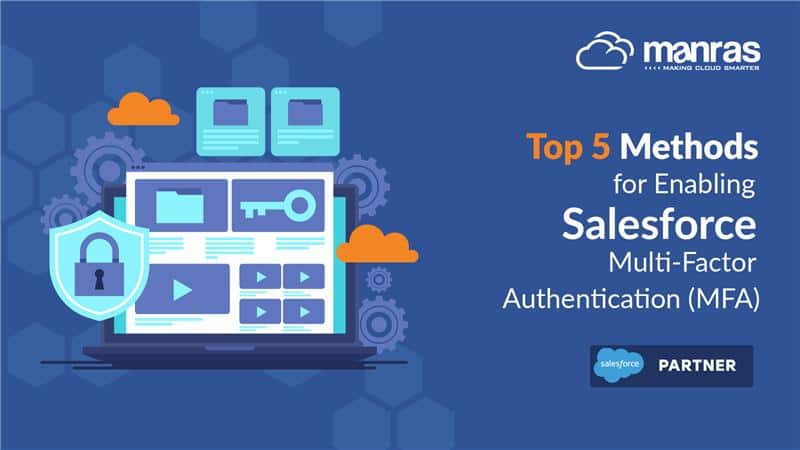
Top 5 Methods for Enabling Salesforce Multi-Factor Authentication (MFA)
Since February 1, 2022, Salesforce has mandated Multi-Factor Authentication (MFA) for anyone logging directly into the platform. This requirement enhances security by adding an additional layer of verification beyond just a username and password. In this article, we’ll look at the significance of Salesforce MFA, explore the various MFA options for Salesforce users, and provide top five methods for enabling Salesforce login security.
What is Salesforce Multi-Factor Authentication (MFA)?
Salesforce MFA is a security protocol that requires users to provide two or more verification factors to gain access to their accounts. Typically, this includes something they know (like a password) and something they have (such as a verification code). This method effectively mitigates the risk of unauthorized access, especially in today’s digital landscape where cyber threats are increasingly sophisticated. It’s crucial to distinguish MFA from simple device activation, which may only require a verification code sent via email for new devices.
Who Needs to Use MFA?
Anyone logging into Salesforce through the user interface (UI) at login.salesforce.com or their My Domain URL must use Multi-factor authentication Salesforce. This requirement also extends to users accessing Salesforce through the Salesforce Mobile App. While external users logging into Experience Cloud Sites are currently exempt from this requirement, it’s a recommended best practice to implement MFA for all accounts, including sandbox environments, to safeguard data.
Why is Salesforce MFA Important?
The benefits of using Salesforce MFA cannot be overstated. With the rise of data breaches and unauthorized access incidents, ensuring robust Salesforce security is paramount. MFA not only helps organizations comply with regulatory standards but also fosters user confidence by protecting sensitive information. By implementing MFA, businesses significantly reduce their vulnerability to credential theft, phishing attacks, and other forms of cybercrime.
How to Enable Salesforce Multi-Factor Authentication?
Enabling Salesforce MFA is a critical step in enhancing security. Here is how to set up multi-factor authentication in Salesforce:
Method 1: Salesforce Authenticator Mobile App
The Salesforce Authenticator app is a primary tool provided by Salesforce for MFA. Available on both iOS and Android platforms, this mobile app generates a unique verification code that users can enter during the login process. One of the standout features of the Salesforce Authenticator is the ability to set up Trusted Locations, allowing users to approve logins from known devices and locations after a few successful logins. This not only streamlines the authentication process but also adds convenience for users who regularly access Salesforce from the same devices.
Method 2: Using SMS Authentication for Salesforce MFA
SMS Authentication offers a straightforward method for users to receive one-time codes via text message when attempting to log in. While this method is easy to set up and widely used, it does come with some drawbacks. SMS can be susceptible to interception or phishing attacks, which raises concerns about security. Despite these risks, many organizations opt for SMS as a supplementary method alongside more secure options.
Method 3: Time-based One-Time Password (TOTP) Authenticator Apps
TOTP Authenticator Apps, such as Google Authenticator or Microsoft Authenticator, provide another secure option for Salesforce MFA. These apps generate unique, time-sensitive codes that users can enter during login. The process for setting up TOTP involves scanning a QR code during the initial configuration, making it easy for users to get started. Since these apps do not rely on mobile networks, they are generally more secure than SMS methods.
Method 4: Third-Party Authentication Providers
For organizations utilizing Single Sign-On (SSO), integrating Third-Party Authentication Providers is a viable solution for Salesforce MFA. Providers like OKTA and Azure AD allow users to authenticate through familiar systems, thereby streamlining the login process while ensuring robust security measures are in place. By offloading the MFA requirement to an SSO provider, organizations can enhance the user experience while maintaining high-security standards.
Method 5: Security Keys for Salesforce MFA
Security Keys offer a physical method of authentication that requires users to have a specific device, such as a USB or NFC key, to complete the login process. This method provides an added layer of security, especially for users who may not have access to mobile devices. While there is an upfront cost associated with acquiring these keys, they serve as a strong defense against unauthorized access and are a suitable alternative for organizations looking to enhance their Salesforce login security.
Common Challenges When Enabling Salesforce MFA
While implementing Salesforce MFA is crucial, organizations may face challenges such as user resistance and technical issues during setup. Ensuring that all users have access to the necessary devices and understand how to use them is essential for a smooth transition. Organizations can mitigate these challenges through comprehensive training and support, ensuring users recognize the value of MFA in protecting their accounts.
Best Practices for Using Salesforce MFA
To maximize the effectiveness of Salesforce MFA, organizations should leverage best methods to enable Salesforce MFA. This can be done by encouraging users to register multiple authentication methods. This redundancy ensures that if one method fails, users have alternatives readily available. Additionally, Salesforce administrators should guide users in managing their MFA settings through personal configurations, which can improve user experience and compliance.
Conclusion
In conclusion, enabling Multi-Factor Authentication (MFA) in Salesforce is a critical step in enhancing Salesforce security and protecting valuable data. By adhering to the Salesforce MFA setup guide and adopting various MFA methods, organizations can significantly reduce the risk of unauthorized access and comply with Salesforce’s stringent security requirements.
To streamline this process and ensure effective implementation, collaborating with experts like Manras, a certified Salesforce consultant, can be invaluable. Manras provides tailored guidance and support, helping organizations adopt the best practices for Salesforce MFA while optimizing user experience and security.



